trunk SUBARU IMPREZA WRX 2006 2.G Owners Manual
[x] Cancel search | Manufacturer: SUBARU, Model Year: 2006, Model line: IMPREZA WRX, Model: SUBARU IMPREZA WRX 2006 2.GPages: 365, PDF Size: 7.09 MB
Page 6 of 365
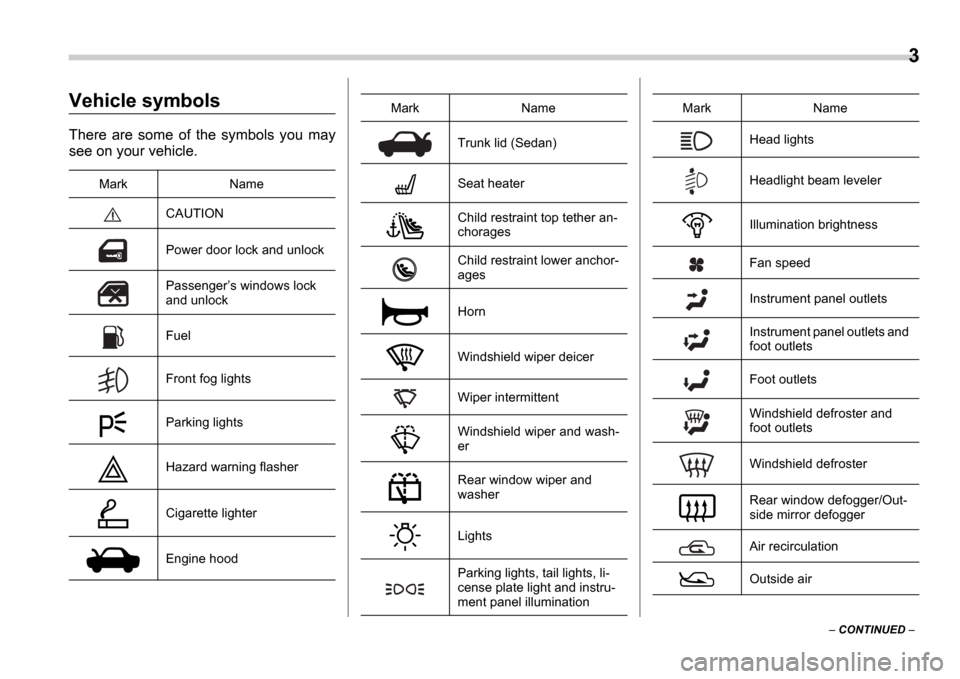
3
CONTINUED
Vehicle symbols
There are some of the symbols you may
see on your vehicle.
Mark Name
CAUTION
Power door lock and unlock
Passengers windows lock
and unlock
Fuel
Front fog lights
Parking lights
Hazard warning flasher
Cigarette lighter
Engine hood
Trunk lid (Sedan)
Seat heater
Child restraint top tether an-
chorages
Child restraint lower anchor-
ages
Horn
Windshield wiper deicer
Wiper intermittent
Windshield wiper and wash-
er
Rear window wiper and
washer
Lights
Parking lights, tail lights, li-
cense plate light and instru-
ment panel illumination
Mark NameHead lights
Headlight beam leveler
Illumination brightness
Fan speed
Instrument panel outlets
Instrument panel outlets and
foot outlets
Foot outlets
Windshield defroster and
foot outlets
Windshield defroster
Rear window defogger/Out-
side mirror defogger
Air recirculation
Outside air
Mark Name
Page 8 of 365
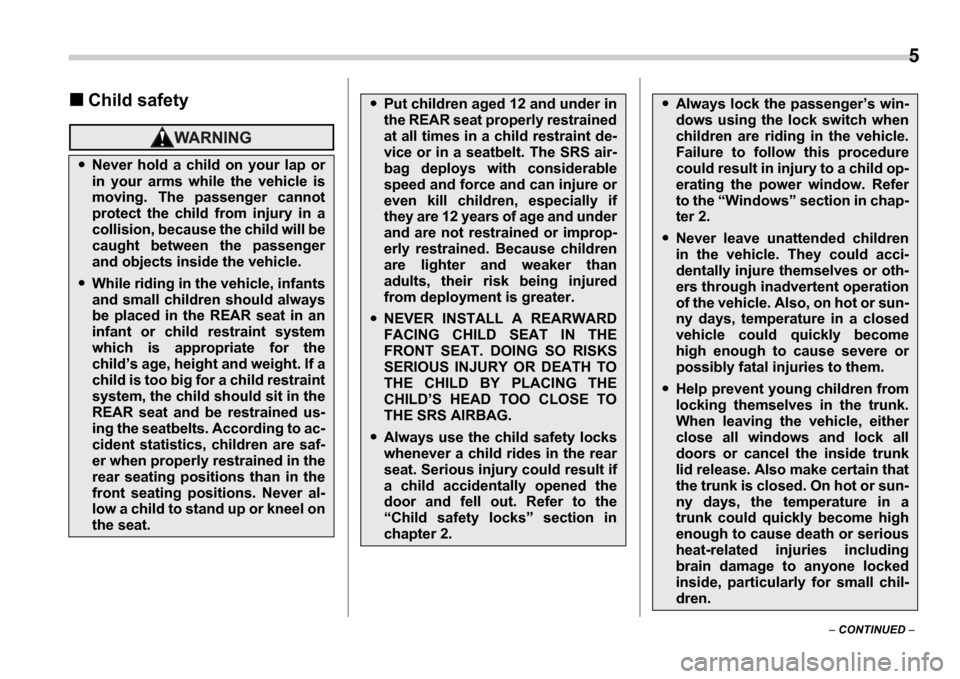
5
CONTINUED
Child safety
Never hold a child on your lap or
in your arms while the vehicle is
moving. The passenger cannot
protect the child from injury in a
collision, because the child will be
caught between the passenger
and objects inside the vehicle.
While riding in the vehicle, infants
and small children should always
be placed in the REAR seat in an
infant or child restraint system
which is appropriate for the
childs age, height and weight. If a
child is too big for a child restraint
system, the child should sit in the
REAR seat and be restrained us-
ing the seatbelts. According to ac-
cident statistics, children are saf-
er when properly restrained in the
rear seating positions than in the
front seating positions. Never al-
low a child to stand up or kneel on
the seat.
Put children aged 12 and under in
the REAR seat properly restrained
at all times in a child restraint de-
vice or in a seatbelt. The SRS air-
bag deploys with considerable
speed and force and can injure or
even kill children, especially if
they are 12 years of age and under
and are not restrained or improp-
erly restrained. Because children
are lighter and weaker than
adults, their risk being injured
from deployment is greater.
NEVER INSTALL A REARWARD
FACING CHILD SEAT IN THE
FRONT SEAT. DOING SO RISKS
SERIOUS INJURY OR DEATH TO
THE CHILD BY PLACING THE
CHILD S HEAD TOO CLOSE TO
THE SRS AIRBAG.
Always use the child safety locks
whenever a child rides in the rear
seat. Serious injury could result if
a child accidentally opened the
door and fell out. Refer to the Child safety locks section in
chapter 2.
Always lock the passenger s win-
dows using the lock switch when
children are riding in the vehicle.
Failure to follow this procedure
could result in injury to a child op-
erating the power window. Refer
to the Windows section in chap-
ter 2.
Never leave unattended children
in the vehicle. They could acci-
dentally injure themselves or oth-
ers through inadvertent operation
of the vehicle. Also, on hot or sun-
ny days, temperature in a closed
vehicle could quickly become
high enough to cause severe or
possibly fatal injuries to them.
Help prevent young children from
locking themselves in the trunk.
When leaving the vehicle, either
close all windows and lock all
doors or cancel the inside trunk
lid release. Also make certain that
the trunk is closed. On hot or sun-
ny days, the temperature in a
trunk could quickly become high
enough to cause death or serious
heat-related injuries including
brain damage to anyone locked
inside, particularly for small chil-
dren.
Page 9 of 365
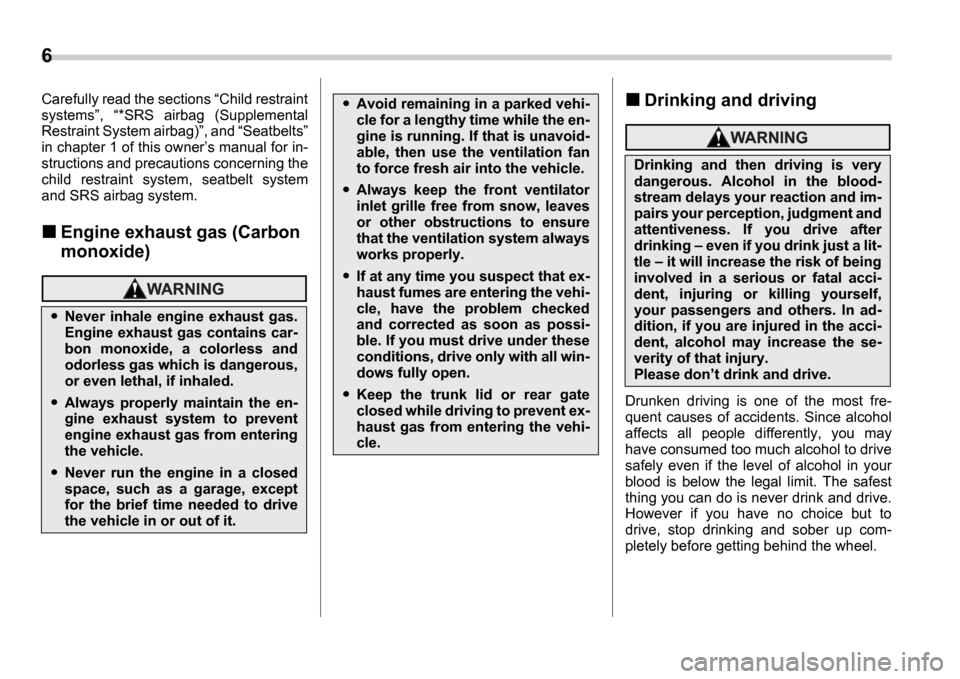
6
Carefully read the sections Child restraint
systems , *SRS airbag (Supplemental
Restraint System airbag) , and Seatbelts
in chapter 1 of this owner s manual for in-
structions and precautions concerning the
child restraint system, seatbelt system
and SRS airbag system.
Engine exhaust gas (Carbon
monoxide)
Drinking and driving
Drunken driving is one of the most fre-
quent causes of accidents. Since alcohol
affects all people differently, you may
have consumed too much alcohol to drive
safely even if the level of alcohol in your
blood is below the legal limit. The safest
thing you can do is never drink and drive.
However if you have no choice but to
drive, stop drinking and sober up com-
pletely before getting behind the wheel.
Never inhale engine exhaust gas.
Engine exhaust gas contains car-
bon monoxide, a colorless and
odorless gas which is dangerous,
or even lethal, if inhaled.
Always properly maintain the en-
gine exhaust system to prevent
engine exhaust gas from entering
the vehicle.
Never run the engine in a closed
space, such as a garage, except
for the brief time needed to drive
the vehicle in or out of it.
Avoid remaining in a parked vehi-
cle for a lengthy time while the en-
gine is running. If that is unavoid-
able, then use the ventilation fan
to force fresh air into the vehicle.
Always keep the front ventilator
inlet grille free from snow, leaves
or other obstructions to ensure
that the ventilation system always
works properly.
If at any time you suspect that ex-
haust fumes are entering the vehi-
cle, have the problem checked
and corrected as soon as possi-
ble. If you must drive under these
conditions, drive only with all win-
dows fully open.
Keep the trunk lid or rear gate
closed while driving to prevent ex-
haust gas from entering the vehi-
cle.
Drinking and then driving is very
dangerous. Alcohol in the blood-
stream delays your reaction and im-
pairs your perception, judgment and
attentiveness. If you drive after
drinking even if you drink just a lit-
tle it will increase the risk of being
involved in a serious or fatal acci-
dent, injuring or killing yourself,
your passengers and others. In ad-
dition, if you are injured in the acci-
dent, alcohol may increase the se-
verity of that injury.
Please don t drink and drive.
Page 14 of 365
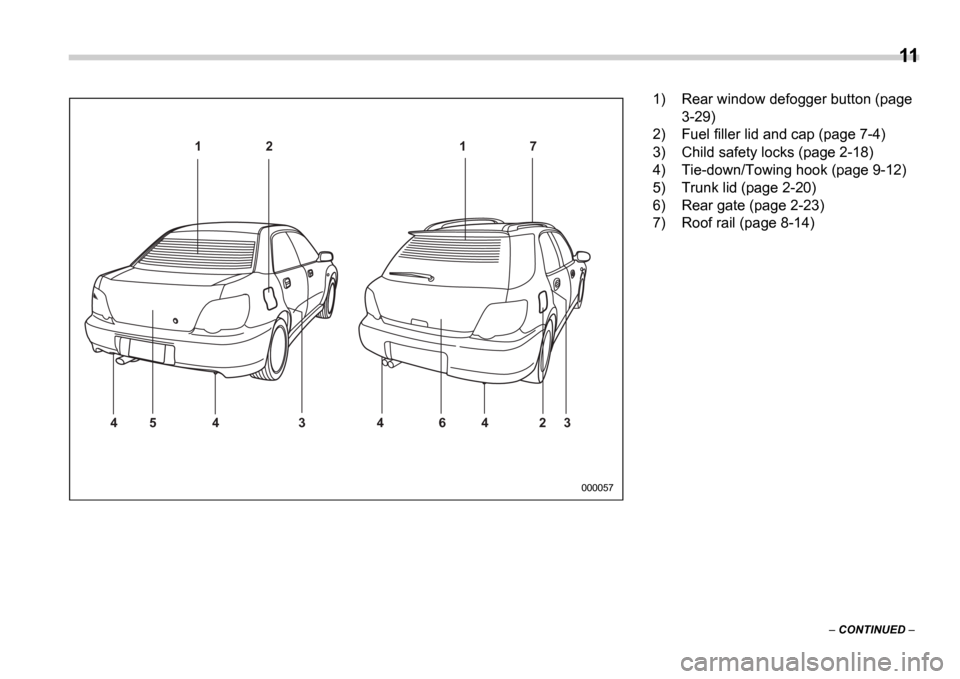
11
CONTINUED
1 2
3 4 4 6 2 3
4
4 5 1 7
000057
1) Rear window defogger button (page
3-29)
2) Fuel filler lid and cap (page 7-4)
3) Child safety locks (page 2-18)
4) Tie-down/Towing hook (page 9-12)
5) Trunk lid (page 2-20)
6) Rear gate (page 2-23)
7) Roof rail (page 8-14)
Page 88 of 365

2
Keys and doors
Keys ..................................................................... 2-2
Key number ........................................ ..................... 2-2
Immobilizer (Turbo models) ......................... ..... 2-3
Security ID plate ................................. .................... 2-3
Security indicator light .......................... ................. 2-3
Key replacement ................................... .................. 2-4
Door locks ........................................ ................... 2-4
Locking and unlocking from the outside ............ . 2-4
Locking and unlocking from the inside ............. ... 2-5
Key lock-in prevention function ................... ......... 2-5
Power door locking switches ....................... ..... 2-6
Remote keyless entry system ....................... .... 2-7
Locking the doors ................................. ................. 2-7
Unlocking the doors ............................... ................ 2-8
Illuminated entry ................................. .................... 2-8
Vehicle finder function ........................... ................ 2-8
Sounding a panic alarm ............................ ............. 2-8
Selecting audible signal operation ................ ....... 2-8
Replacing the battery ............................. ................ 2-9
Replacing lost transmitters ....................... ............ 2-10
Alarm system ...................................... ................ 2-13
System alarm operation ............................ ............. 2-13
Activating and deactivating the alarm system ..... 2 -13
If you have accidentally triggered the alarm
system ............................................ ....................... 2-14
Arming the system ................................. ................ 2-14
Disarming the system .............................. .............. 2-15
Valet mode ........................................ ...................... 2-16
Passive arming .................................... ................... 2-16Tripped sensor identification .....................
........... 2-17
Shock sensors (dealer option) ..................... ......... 2-17
Child safety locks ................................ ............... 2-18
Windows ........................................... ................... 2-18
Power windows ..................................... .................. 2-18
Trunk lid (Sedan) ................................. ............... 2-20
To open and close the trunk lid from outside ...... 2-20
To open the trunk lid from inside ................. ......... 2-21
To cancel the trunk lid release ................... ........... 2-21
Internal trunk lid release handle ................. ........... 2-21
Rear gate (Wagon) ................................. ............. 2-23
Moonroof (if equipped) ............................ .......... 2-24
Tilt function ..................................... ........................ 2-24
Sliding function .................................. ..................... 2-24
Sun shades ........................................ ...................... 2-25
Page 89 of 365
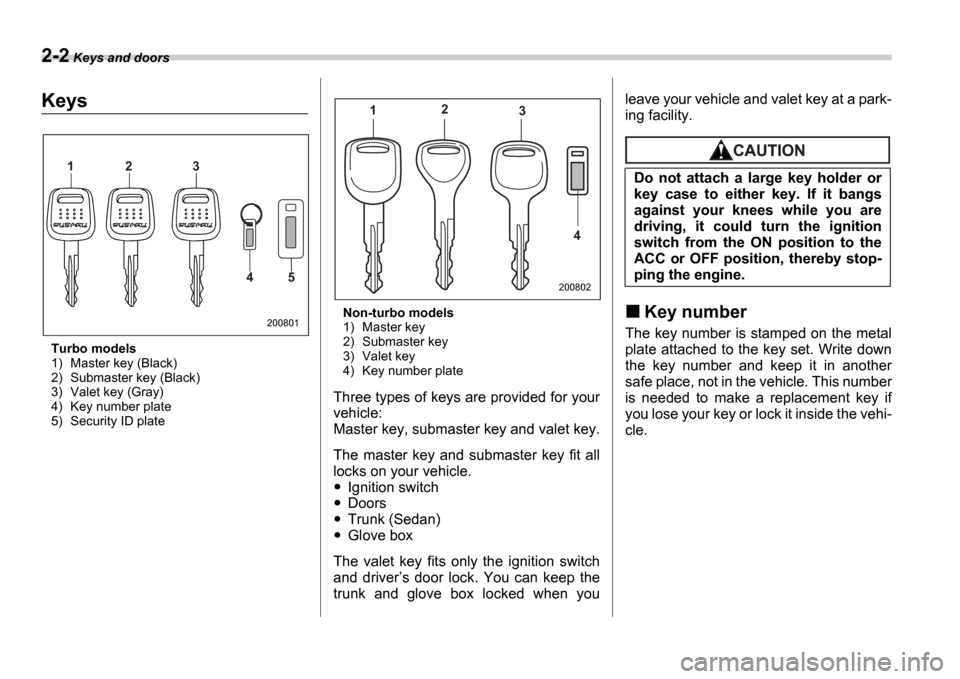
2-2 Keys and doors
Keys and doorsKeys
Turbo models
1) Master key (Black)
2) Submaster key (Black)
3) Valet key (Gray)
4) Key number plate
5) Security ID plate Non-turbo models
1) Master key
2) Submaster key
3) Valet key
4) Key number plate
Three types of keys are provided for your
vehicle:
Master key, submaster key and valet key.
The master key and submaster key fit all
locks on your vehicle.
Ignition switch
Doors
Trunk (Sedan)
Glove box
The valet key fits only the ignition switch
and driver s door lock. You can keep the
trunk and glove box locked when you leave your vehicle and valet key at a park-
ing facility.
Key number
The key number is stamped on the metal
plate attached to the key set. Write down
the key number and keep it in another
safe place, not in the vehicle. This number
is needed to make a replacement key if
you lose your key or lock it inside the vehi-
cle.
1 2 3
4 5
200801
12
3
4
200802
Do not attach a large key holder or
key case to either key. If it bangs
against your knees while you are
driving, it could turn the ignition
switch from the ON position to the
ACC or OFF position, thereby stop-
ping the engine.
Page 97 of 365
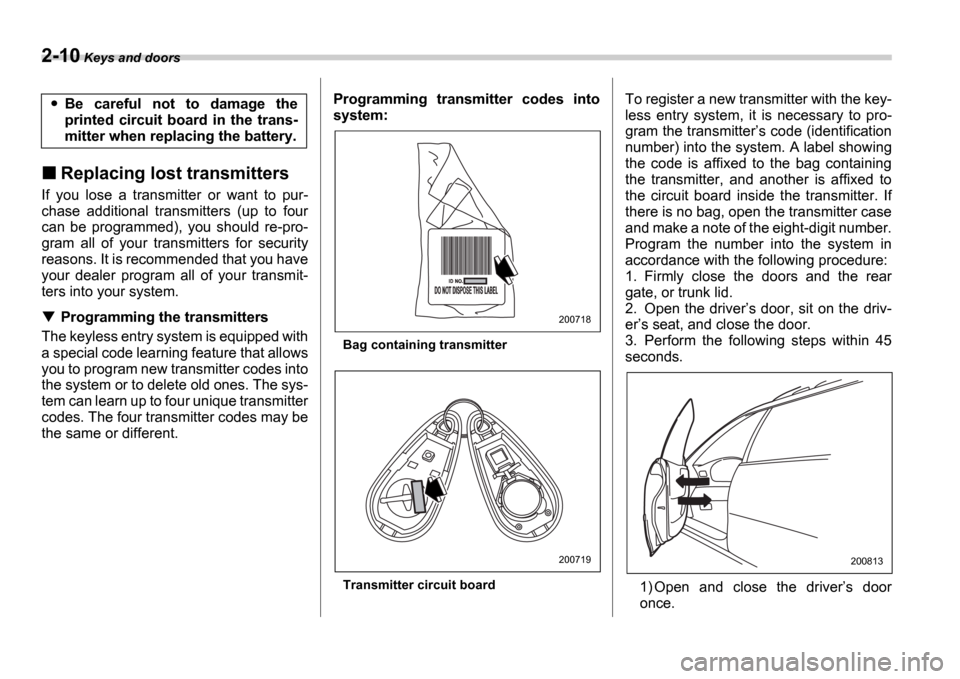
2-10 Keys and doors
Replacing lost transmitters
If you lose a transmitter or want to pur-
chase additional transmitters (up to four
can be programmed), you should re-pro-
gram all of your transmitters for security
reasons. It is recommended that you have
your dealer program all of your transmit-
ters into your system.
Programming the transmitters
The keyless entry system is equipped with
a special code learning feature that allows
you to program new transmitter codes into
the system or to delete old ones. The sys-
tem can learn up to four unique transmitter
codes. The four transmitter codes may be
the same or different. Programming transmitter codes into
system:
Bag containing transmitter
Transmitter circuit board
To register a new transmitter with the key-
less entry system, it is necessary to pro-
gram the transmitter
s code (identification
number) into the system. A label showing
the code is affixed to the bag containing
the transmitter, and another is affixed to
the circuit board inside the transmitter. If
there is no bag, open the transmitter case
and make a note of the eight-digit number.
Program the number into the system in
accordance with the following procedure:
1. Firmly close the doors and the rear
gate, or trunk lid.
2. Open the driver s door, sit on the driv-
er s seat, and close the door.
3. Perform the following steps within 45
seconds.
1) Open and close the driver s door
once.Be careful not to damage the
printed circuit board in the trans-
mitter when replacing the battery.
200718
200719200813
Page 100 of 365

Keys and doors 2-13
CONTINUED
access to your vehicle.
Alarm system
The alarm system helps to protect your
vehicle and valuables from theft. The horn
sounds and the turn signal lights flash if
someone attempts to break into your vehi-
cle. The starter motor is also interrupted to
prevent starting the vehicle without a key.
The system can be armed and disarmed
with the remote transmitter.
The system does not operate when the
key is inserted into the ignition switch.
Your vehicle
s alarm system has been set
for activation at the time of shipment from
the factory. You can set the system for de-
activation yourself or have it done by your
SUBARU dealer.
System alarm operation
The alarm system will give the following
alarms when triggered:
The vehicle s horn will sound and the
turn signal lights will flash for 30 seconds.
In addition, the starter motor will not oper-
ate.
If any door (or the rear gate/trunk lid) re-
mains open after the 30-second period,
the horn will continue to sound for a maxi-
mum of 3 minutes. If the door (or the rear
gate/trunk lid) is closed while the horn is sounding, the horn will stop sounding with
a delay of up to 30 seconds.
The alarm is triggered by:
Opening a door, the rear gate or trunk
lid
Physical impact to the vehicle, such as
forced entry (only vehicles with shock sen-
sors (dealer option))
Activating and deactivating
the alarm system
To change the setting of your vehicle s
alarm system for activation or deactiva-
tion, do the following.
1. Disarm the alarm system (see Disarm-
ing the system in this section).
2. Sit in the driver s seat and shut all
doors (and the rear gate if your vehicle is
a Wagon).
3. Turn the ignition switch to the ON po-
sition.
4. Hold down the UNLOCK side of the
driver s power door locking switch, open
the driver s door within the following 1 sec-
ond, and wait 10 seconds without releas-
ing the switch. The setting will then be
changed as follows:
If the system was previously activated:
The odometer/trip meter screen displays AL oF and the horn sounds twice, indi-
Page 101 of 365
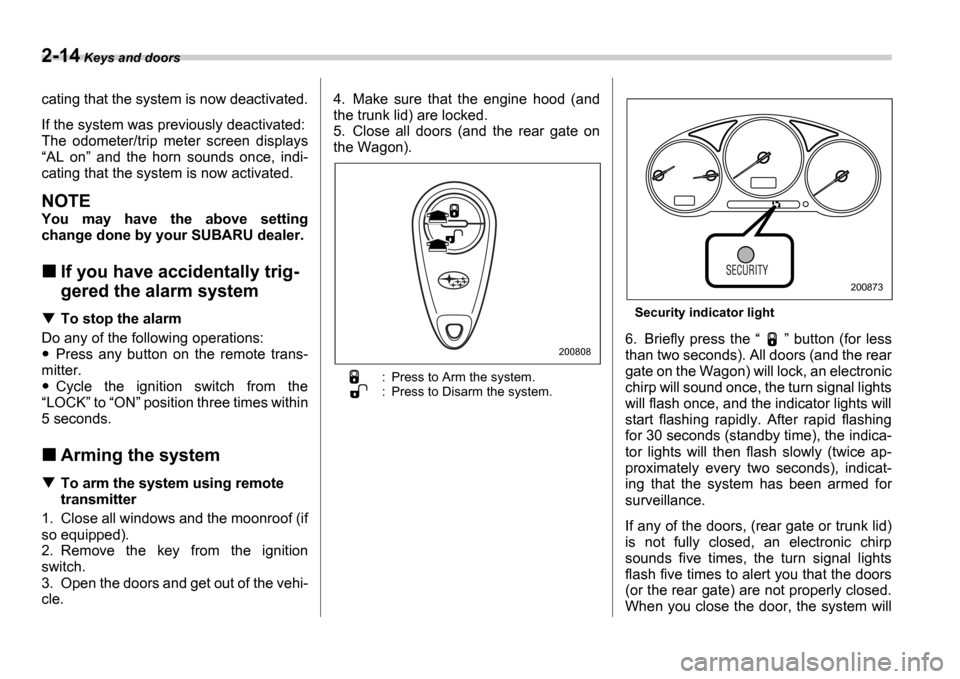
2-14 Keys and doors
cating that the system is now deactivated.
If the system was previously deactivated:
The odometer/trip meter screen displays AL on and the horn sounds once, indi-
cating that the system is now activated.
NOTE
You may have the above setting
change done by your SUBARU dealer.
If you have accidentally trig-
gered the alarm system
To stop the alarm
Do any of the following operations:
Press any button on the remote trans-
mitter.
Cycle the ignition switch from the
LOCK to ON position three times within
5 seconds.
Arming the system
To arm the system using remote
transmitter
1. Close all windows and the moonroof (if
so equipped).
2. Remove the key from the ignition
switch.
3. Open the doors and get out of the vehi-
cle. 4. Make sure that the engine hood (and
the trunk lid) are locked.
5. Close all doors (and the rear gate on
the Wagon).
: Press to Arm the system.
: Press to Disarm the system.
Security indicator light
6. Briefly press the
button (for less
than two seconds). All doors (and the rear
gate on the Wagon) will lock, an electronic
chirp will sound once, the turn signal lights
will flash once, and the indicator lights will
start flashing rapidly. After rapid flashing
for 30 seconds (standby time), the indica-
tor lights will then flash slowly (twice ap-
proximately every two seconds), indicat-
ing that the system has been armed for
surveillance.
If any of the doors, (rear gate or trunk lid)
is not fully closed, an electronic chirp
sounds five times, the turn signal lights
flash five times to alert you that the doors
(or the rear gate) are not properly closed.
When you close the door, the system will200808
200873
Page 102 of 365
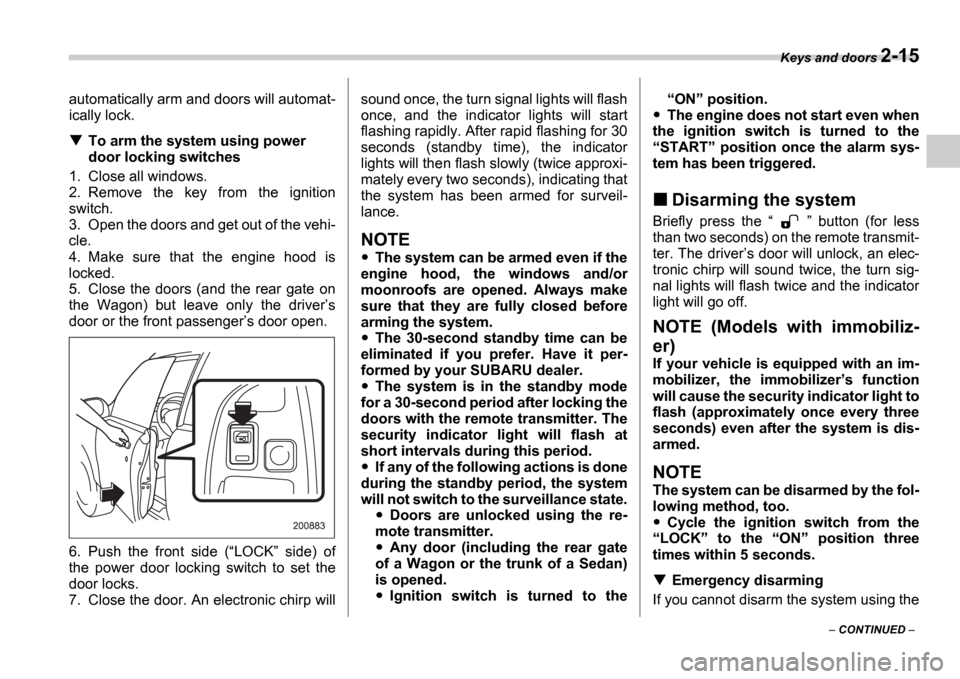
Keys and doors 2-15
CONTINUED
automatically arm and doors will automat-
ically lock.
To arm the system using power
door locking switches
1. Close all windows.
2. Remove the key from the ignition
switch.
3. Open the doors and get out of the vehi-
cle.
4. Make sure that the engine hood is
locked.
5. Close the doors (and the rear gate on
the Wagon) but leave only the driver s
door or the front passenger s door open.
6. Push the front side ( LOCK side) of
the power door locking switch to set the
door locks.
7. Close the door. An electronic chirp will sound once, the turn signal lights will flash
once, and the indicator lights will start
flashing rapidly. After rapid flashing for 30
seconds (standby time), the indicator
lights will then flash slowly (twice approxi-
mately every two seconds), indicating that
the system has been armed for surveil-
lance.
NOTE
The system can be armed even if the
engine hood, the windows and/or
moonroofs are opened. Always make
sure that they are fully closed before
arming the system.
The 30-second standby time can be
eliminated if you prefer. Have it per-
formed by your SUBARU dealer.
The system is in the standby mode
for a 30-second period after locking the
doors with the remote transmitter. The
security indicator light will flash at
short intervals during this period.
If any of the following actions is done
during the standby period, the system
will not switch to the surveillance state.
Doors are unlocked using the re-
mote transmitter.
Any door (including the rear gate
of a Wagon or the trunk of a Sedan)
is opened.
Ignition switch is turned to the
ON position.
The engine does not start even when
the ignition switch is turned to the START position once the alarm sys-
tem has been triggered.
Disarming the system
Briefly press the button (for less
than two seconds) on the remote transmit-
ter. The driver s door will unlock, an elec-
tronic chirp will sound twice, the turn sig-
nal lights will flash twice and the indicator
light will go off.
NOTE (Models with immobiliz-
er)
If your vehicle is equipped with an im-
mobilizer, the immobilizer s function
will cause the security indicator light to
flash (approximately once every three
seconds) even after the system is dis-
armed.
NOTE
The system can be disarmed by the fol-
lowing method, too.
Cycle the ignition switch from the
LOCK to the ON position three
times within 5 seconds.
Emergency disarming
If you cannot disarm the system using the